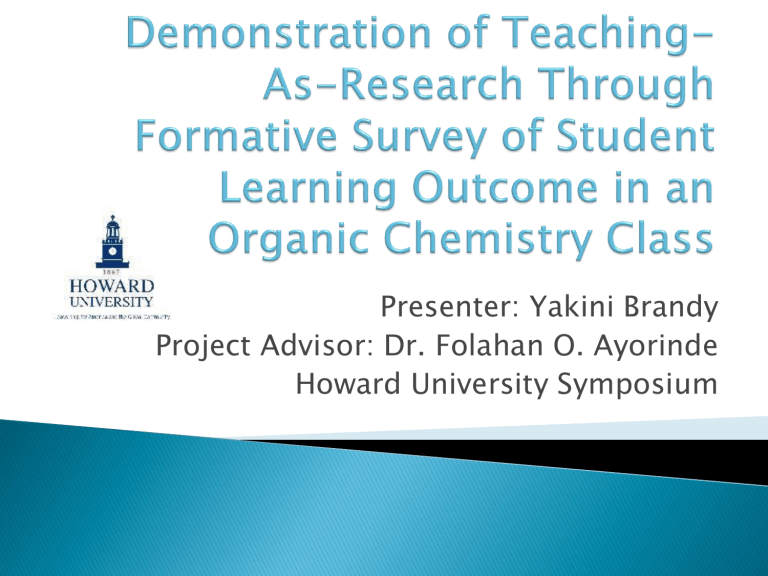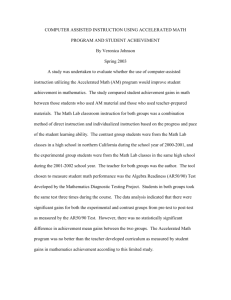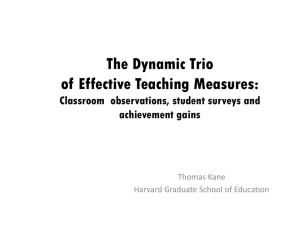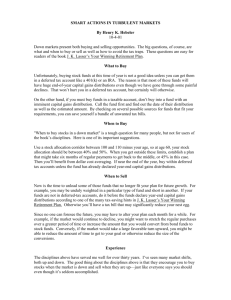Slide 1 - CIRTL Network

Presenter: Yakini Brandy
Project Advisor: Dr. Folahan O. Ayorinde
Howard University Symposium
Cartoon Illustrating Today’s Students
Adopted from: http://dragonlady328pt.blogspot.com/2006/09/technology-issues.html
(Sept. 06, 2006)
The CIRTL NETWORK
Center for the Integration of Research, Teaching, and Learning
(CIRTL)
Howard University
Michigan State University
Texas A&M University
University of Colorado at Boulder
University of Wisconsin-Madison
Vanderbilt University
Mission:
To enhance the Professional Development of Graduate
Students and develop a national STEM faculty committed to advancing effective teaching practices for diverse student audiences
The CIRTL Network
◦
Enhances the development of STEM graduate students and faculty by
Promoting 3 pillars :
Teaching-as-Research (TAR)
Learning Communities
Learning-through-Diversity
www.cirtl.net
Learning foundational knowledge
Creating objectives for student learning
Developing an hypothesis for practices to achieve the learning objectives
Defining measures of success
Developing and implementing teaching practices within an experimental design
Collecting and analyzing data
Reflecting, evaluating, and iterating
To use and apply the TAR steps in generating a project that involves the use of technology to enhance teaching and learning.
To conduct weekly surveys to integrate technology into pedagogy in an undergraduate organic chemistry class of 60 students.
To use the data obtained as guidance in the re-lecture of a specific concept and to monitor students’ progress.
Lectures were conducted on a specific chapter during the week.
The learning objectives were used to compose learning outcome surveys.
Each student rated the survey questions based on how much knowledge they gained on a concept.
Data were analyzed and findings were shared with the professor.
Professor used initial surveys as guidance in the following week’s lecture: concepts were revisited if less than 80% of the students accomplished that learning objective.
Line Graph compares Class Paticipation for
Initial and Final Surveys
50
40
30
20
10
0
Initial Survey
Final Survey
1
40
29
2
23
40
3
33
35
4
39
37
Upon successful completion of this chapter, you should be able to,
Identify enolate anions
Know which compounds can form enolate anions
Know how to form enolate anions
Identify enols
Know how to use enolate anions as nucleophiles to form new carbon-carbon bonds
Know how to use enolate anions to synthesize alpha-bromo aldehydes, ketones, and esters
Know the relative acidity of organic compounds
Know factors that affect the relative acidity of organic compounds
Know the relationship between pka and acidity
Know what the Hell-Volhard-Zelinskii reaction is
Know what the malonic ester synthesis is
Know what the acetoacetic ester synthesis is
An Example of a Chapter Objectives
Outlined by the Professor
Initial Moderate - Great Gains
Carboxylic Acids and Nitriles
Final Moderate - Great Gains Initial Little - No Gains
100,0%
90,0%
80,0%
70,0%
60,0%
50,0%
40,0%
30,0%
20,0%
10,0%
0,0%
Final Little - No Gains
Survey Questions
Carboxylic Acids and Nitriles
Initial Moderate-Great Gains Final Moderate-Great Gains Initial Little-No Gains Final Little-No Gains
90,0%
80,0%
70,0%
60,0%
50,0%
40,0%
30,0%
20,0%
10,0%
0,0%
Knowing how to convert carboxylic acids to acid chlorides
Survey Questions
Initial Moderate - Great Gains
100,0%
90,0%
80,0%
70,0%
60,0%
50,0%
40,0%
30,0%
20,0%
10,0%
0,0%
Enols
Final Moderate - Great Gains Initial Little - No Gains Final Little - No Gains
Survey Questions
Initial Moderate-Great Gains
Enols
Final Moderate-Great Gains Initial Little-No Gains Final Little-No Gains
90,0%
80,0%
70,0%
60,0%
50,0%
40,0%
30,0%
20,0%
10,0%
0,0%
How to form new carbon-carbon bonds using enolate anions
Survey Question
TAR can be used to enhance students’ learning outcomes.
Effort should be made to inform students of the importance of maintaining survey integrity.
The survey project is still ongoing in the organic chemistry class to improve the teaching practices and learning experience of the students and professors.
Dr. Folahan O. Ayorinde
Shemelis Hailu
Pogisego Dinake
CIRTL Network
NSF






